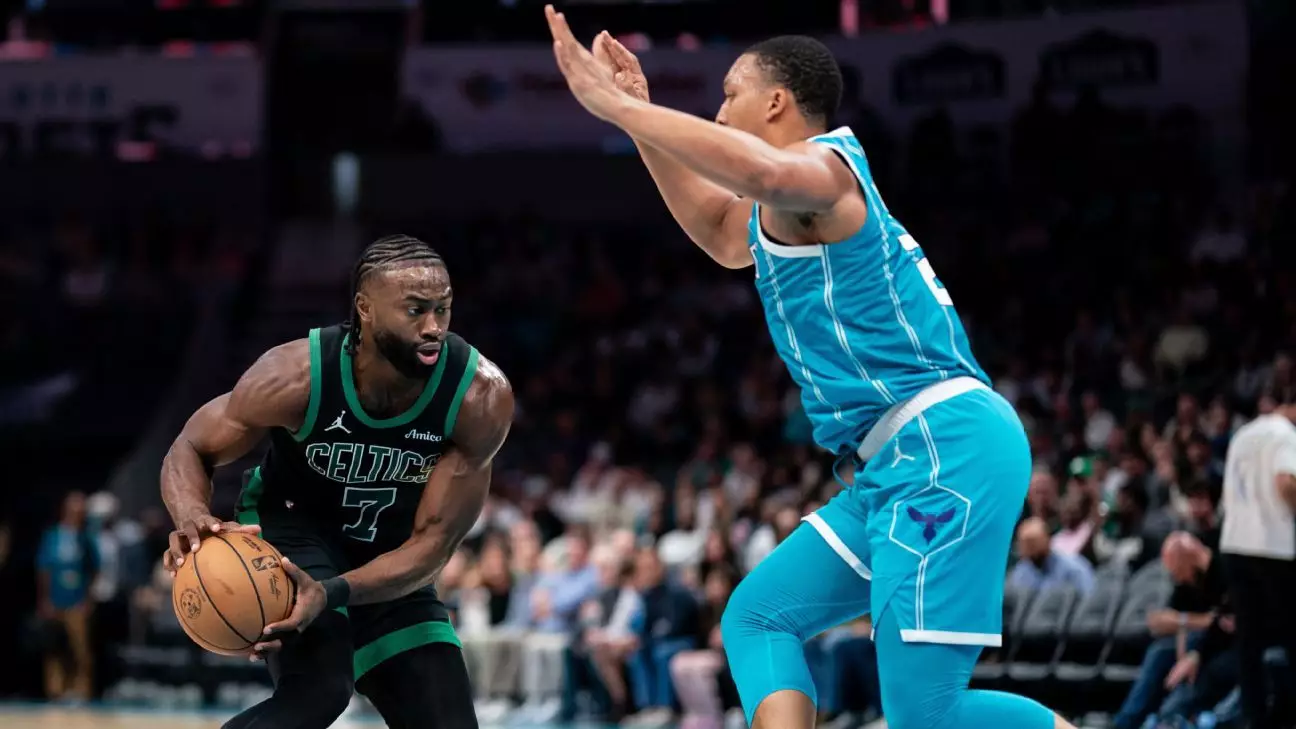On a night meant to celebrate athletic prowess, the Boston Celtics emerged victorious against the Charlotte Hornets with a score of 124-109. Jaylen Brown contributed significantly to this win, scoring 25 points and demonstrating his capability as a leading figure on the court. However, the aftermath of the game overshadowed the victory with tensions flaring, particularly involving a hard foul committed by former Celtics teammate Grant Williams against Jayson Tatum. This incident ignited discussions about sportsmanship, ethics, and the emotional stakes players carry, especially when they are faced with contentious rivalries.
The Inciting Incident: A Hard Foul
Late in the game, a pivotal moment occurred when Williams, now a member of the Hornets, collided with Tatum in a manner reminiscent of a football tackle rather than a basketball play. Tatum’s abrupt fall raised alarms about player safety and the spirit of the game. Brown was fast to intervene, confronting Williams and the Hornets bench, signaling not just a defensive reaction for his teammate but a deeper emotional turbulence stemming from the transition between friends and rivals. The pivotal nature of this incident not only altered the game’s momentum but also became a flashpoint for broader discussions about player relationships in the NBA.
Brown’s Passionate Response
Post-game, Brown voiced his frustration vehemently, stating that such a foul has no place in basketball. His description of the incident as akin to “Ray Lewis coming across the middle” clearly indicated that he perceived Williams’ actions as not just aggressive but premeditated. Brown’s comments highlight a common struggle athletes face when loyalty becomes intertwined with competitiveness. The emotion he displayed illustrates how players are not merely athletes but also individuals bound by friendships that can be challenged in the heat of competition.
By pointing out that Williams “know better than that,” Brown emphasized the responsibility players have towards one another, suggesting that past camaraderie should lead to mutual respect even when the stakes are high. This kind of sentiment raises an essential question: how do past relationships influence player conduct during heated matchups?
In contrast to Brown’s fiery rhetoric, Williams offered a more measured response, insisting that the foul was unintentional and merely part of a competitive spirit on the court. His assertion that “it wasn’t trying to hurt anybody” showcases the dichotomy often present in sports: the action may seem aggressive on the surface, but the intent can be vastly different. This difference serves to highlight the gray areas of player interactions and the inevitable miscommunications that can arise in high-stress formats like professional sports.
Williams extends an olive branch of friendship as he reassures that Tatum remains one of his closest comrades in the league. Yet, this situation also emphasizes the delicate balance that players often maintain—teetering between competitive aggression and personal relationship. The challenge becomes even more pronounced when they are faced with protecting their teammates while navigating the complexities of sportsmanship.
Team Dynamics and the Aftermath
Celtics coach Joe Mazzulla provided a grounded perspective post-game, celebrating Tatum’s resilience after sustaining the foul rather than blaming Williams outright. His focus on Tatum’s ability to quickly get back up and continue with the game reflects a mindset of perseverance that often characterizes successful teams. The coaching perspective serves to reinforce synergy and mental fortitude rather than allowing emotional incidents to disrupt team cohesion.
However, the evening did not cool down with the initial foul. Moments later, tensions amplified as LaMelo Ball was assessed a flagrant foul against Tatum. The sequence ignited continuous strains of hostility between the teams, provoking discussions around intentionality and retaliation. Brown’s remarks about opponents attempting to “send messages” draw attention to the adversarial psychology inherent in sports. Such statements underline a crucial aspect of competition; maintaining composure amidst a barrage of hostile plays is a cornerstone to achieving success.
With the Celtics scheduled to face the Hornets again, emotions will undoubtedly remain high as both teams process the events of the previous matchup. This forthcoming game presents an opportunity not only for athletic competition but also for healing and understanding among players who once shared a bond. As fans and analysts alike speculate about potential fallout and responses, the narrative will shift from mere gameplay to the intricate dynamics of emotion, rivalry, and respect that often govern the underlying fabric of basketball relationships.
The forthcoming clash between the two teams is not merely a test of skill, but a reflection of the complex interplay of emotions that defines modern professional sports. It will be interesting to observe how these layers unfold in the next encounter and what implications they may have on the season onward.



Leave a Reply